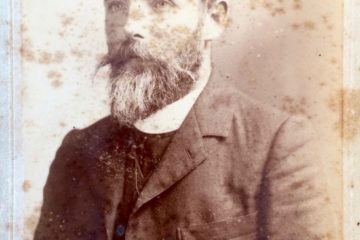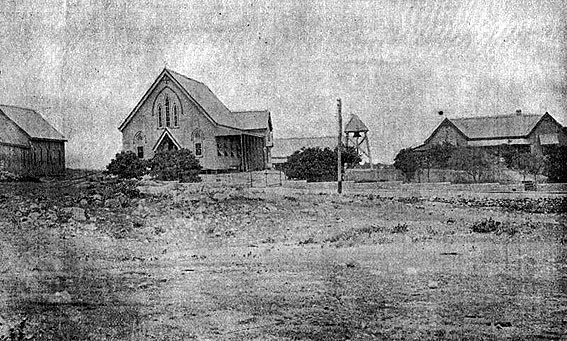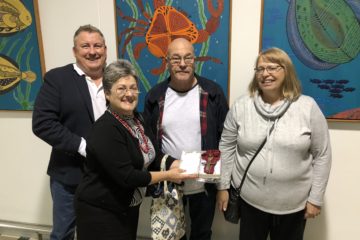Catalyst for formation
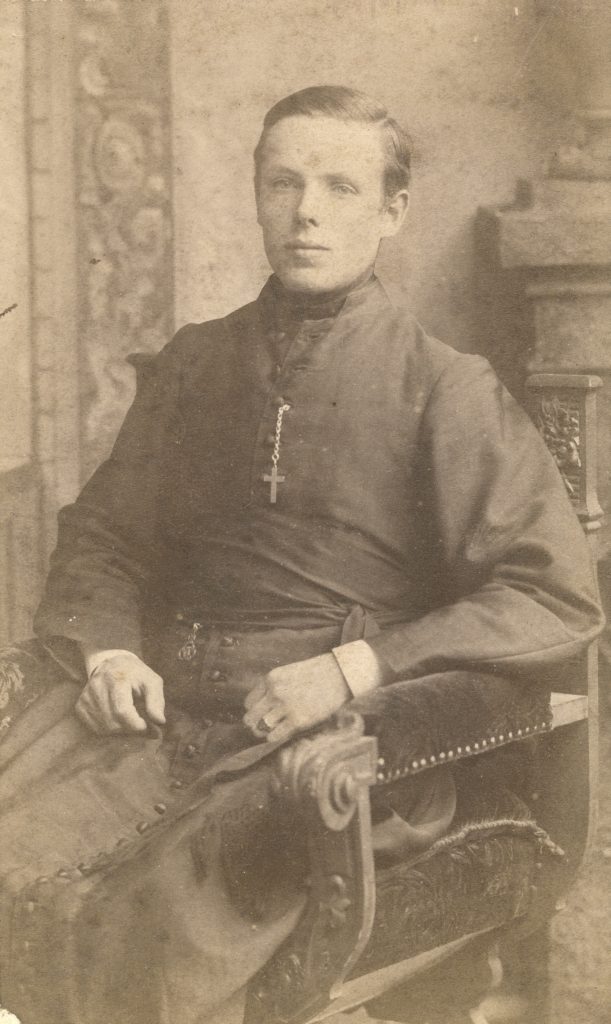
ABOVE: A studio photograph of the newly-minted Deacon David John Garland, in full clerical garb. This image was taken in the early 1890s when Father Garland was still in his 20s and serving in the bush parishes of northern New South Wales. It may even date back to 1887 when the Archdeacon of the Darling Downs, The Venerable Thomas Jones, first took David Garland under his wing at St James’s Church, Toowoomba, in rural Queensland.
THE LATE CANON THOMAS JONES.
A REMINISCENT TRIBUTE.
(By D.J.G., with the A.I.F. abroad.)*
My first acquaintance with the Venerable Thomas Jones was made in the year 1887, when he was Archdeacon of the Darling Downs and Rector of St James’s, Toowoomba.
It was not long before he invited me, as a layman, to help him occasionally in taking services in parts of the huge area under his jurisdiction, some of which had practically little or no religious ministrations except such as he provided.
It was not long after that beginning before he appealed to me as a churchman to entirely abandon secular work and the prospects of a career which were in front of me in order to devote myself entirely to the work of the Church.
His persuasiveness did not take the form of minimising the cost, rather the reverse, but at any rate was so successful that if I have been permitted to do any good in the thirty-one years, which since have elapsed, the credit of it must go to him as the one who give me the opportunity.
Placing me successively in different parts of the archdeaconry, he never left me without sympathetic counsel and advice so essential to a young beginner, nor without any help which he could give, so much so, that looking back upon that period I can say, so wisely did he handle me that never once did I fail to carry out to the utmost his wishes or to do anything which he would not have wished done.
Once a week he brought me into his home and family life, though his time was precious from the demands made upon it by all and sundry – it seemed as if his doorbell never stopped ringing from morning to night, while to walk down the street with him meant that he was stopped every few yards yet he always could find time to talk sympathetically and helpfully to me.
I was welcomed into the family by Mrs Jones [ Francis Sophia Jones, neé Jones ] also, who fully shared his aspirations and without whom the work he did would have been impossible.
Sometimes he would go round the districts with me to administer Holy Baptism – I not being yet ordained – or to look into some problem arising; how well I remember the affection and respect with which he was received in every little home in the bush.
Perhaps the affection and respect is best expressed by a remark made to me by a rough bushman whom I overtook as I rode one day: “If more of you parsons was like Tommy Jones we would be better Christians.”
That was how rich and poor alike thought of him.
Much credit is given to-day to the establishment of Bush Brotherhoods, but I believe the real originator of them was Archdeacon Jones, not that he laid himself out to be the founder of a new order, he just dealt with the immediate need in his own practical way.

ABOVE: St James’s Anglican Church, Toowoomba…cradle of the ministry of many fledgling priests. In the 1880s it was the hub of the Archdeacon of the Darling Downs, Canon Tommy Jones. Photo courtesy of Peter Collins.
The Church of St. James’, Toowoomba, which he loved so well, and the beauty of which owes so much to his personal generosity as well as to gifts obtained by him, he used as a centre to gather around him a body of men, priest, deacon, young laymen, like myself, and sent us out, so ruling us that we were ready to do, and devoted to, whatever he wished; there is no doubt in my mind that thus he solved the problem of church work in the bush.
I happened to be in close spiritual relations with Bishop Dawes [ Nathaniel Dawes ], then Archdeacon of Brisbane, and I have no doubt that when he became Bishop of Rockhampton his knowledge of Archdeacon Jones’s work gave him the model on which to found the first Bush Brotherhood in Australia.
One recollection I have of those days was how full St James’s Church was at the Sunday morning service.
It was nothing infrequent to find the church full, half an hour before service; but this was no uncommon experience in the life of Archdeacon Jones.
In his earlier days, when he was in charge of All Saints’, Brisbane, he went to his Bishop as a young priest seeking advice as to how to deal with the congregation which, before the service, had nearly as many people outside as those who filled it within.
Of his generosity to the Church not much in known, and much is forgotten, but I know how in those days he would travel around to some rising township, and with unerring judgment select a suitable site for a future church.
He would purchase it and hold it at his own risk. If months or years afterwards the local committee would choose to buy it he would let them have it at the price he paid for it without interest; if they did not choose to take it well and good, that was his personal risk, and sometimes loss.
In his generosity to individuals he put into literal practice the principle “Give to him that asketh thee and from him that would borrow of thee turn not thou away.” †
There are not a few businessmen in Queensland who owe their start in life to his financial assistance, and there are many individuals who benefited by his charity to such an extent that at a later period in his life his wealth almost disappeared.
Always regardless of himself, even of his personal appearance, giving money to others while remaining shabby himself, eating simply, without any personal luxury, indeed denying himself comfort, he gave to others that which he might have spent on himself.
One apparent luxury he allowed himself, an occasional trip to other lands, but these were with a purpose, to enlarge his knowledge and to come back with fresh vigour to his work, because, as he said, while in Queensland he could never get away from his work, and he feared he might get stale.
There is one sad episode in his ecclesiastical life – and very shame that such a thing could happen prevents me relating it at length – all the splendid work which he did came suddenly to an end owing to a disagreement on a question of principle with the Bishop of the day.
Archdeacon Jones, with that desire to be charitable which dominated him in everything, thought it better to leave Queensland for a while in the hope that resumed relations would be happier.
Alas, the charity was all on his side, for his living was declared vacant, churches which he had kept open were closed, and remained closed for years, and his band of workers was scattered.
Notwithstanding all this, his charity never failed, for he returned to his old Diocese, willing to take any position, however small or humble; but for two years was denied the opportunity of ministering to the people who loved him so well.
What happened at the end of the two years is known only to the dead, but the Premier of the day paid a visit to the Bishop, with the result that the reproach which the church people considered was cast upon them was removed by the reinstatement of “Mr.” Jones – as he had now become – to his priestly work.
An elderly soldier said to me on learning this week the news that this old Archdeacon and passed away, “Well, we Queensland people never forgave the Bishop for his treatment of the Archdeacon.”
When years afterwards he was again made a dignitary of the Church, it was stated in the Press that more honour was conferred on the Church by Archdeacon Jones’ acceptance than on him by its bestowal.
Retreat and quiet days are not only an accepted, but a regular thing for clergy and laity.
Unless I am mistaken almost the first clerical retreat in Queensland was held by Archdeacon Jones.
Regularly he brought in the clergy and workers of his Archdeaconry to St. James’ Church, where he would get some priest to give addresses during the day, following that up with a conference.
He put himself in the background, never giving the address, and yet he was the spirit of the whole thing; his hospitality was lavish, as was also his generosity to the clergy and workers, for he often paid their expenses that they might be able to come.
In Synod he never hesitated to speak out his views frankly and fearlessly, and yet always with Christian courtesy, with the result that when the matter came to a vote it would be asked: “How is Tommy going to vote?” and in most cases that decided the question, even although, as I myself heard on one occasion, the president himself advised the Synod to vote in the opposite direction.
How the young people loved him, and came to him with all their troubles and joys, and as they grew up brought their courtships to him and then their marriages.
No one but he was to baptise their children, and many and many a one has said, “When I die, get Tommy Jones to bury me.”
But perhaps the best and most, wonderful feature of his life was the extraordinary way he strengthened the faith of individuals.
Perhaps it was his humility, never expressed by words – he was too genuinely humble; perhaps it was even more the way in which be placed himself on a level with his auditor, saying, “I had exactly the same difficulty as you,” and then with gentle persuasion would show why the doubt had ceased or did not oppress him.
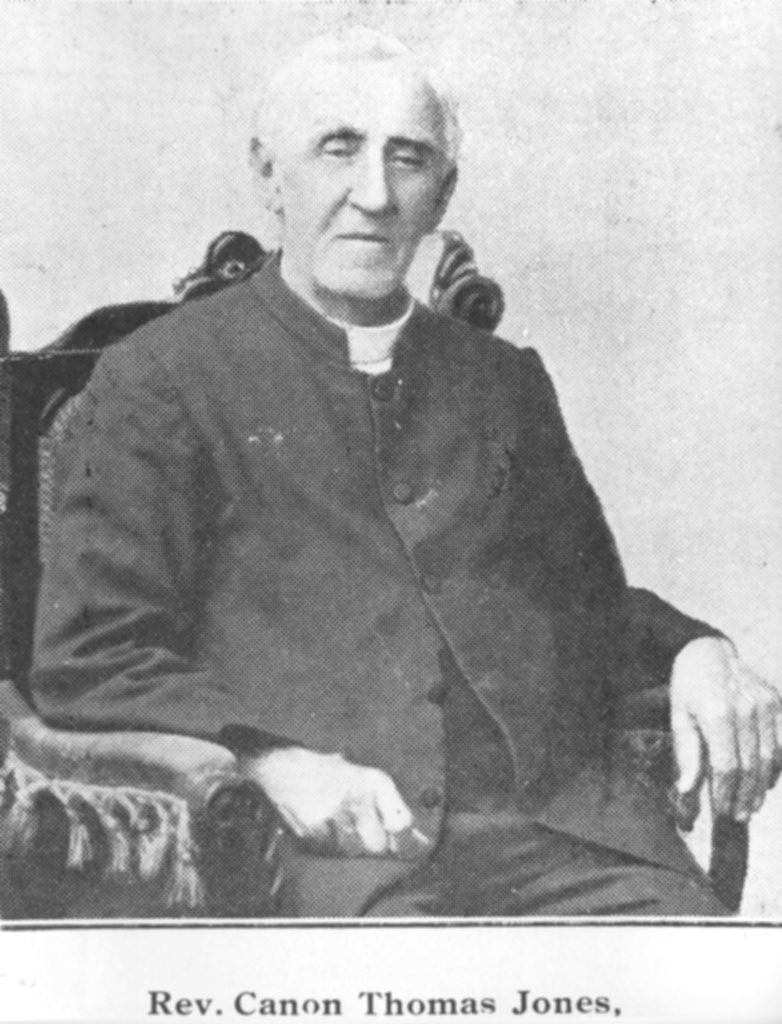
ABOVE: The man to whom David John Garland attributed the honour of providing a template for his own formation as a Church of England cleric.
Many people, not church men, have spoken of him to me as the “grand old man of Queensland”.
His name was a household word; he belonged to the community, and the community regarded him as a man of whom they were most proud.
A new generation has sprung up which knew him not in his strength and vigour.
Sometimes even they would mock at what in his old age appeared to them as comical, little realising that to us of a former generation they were belittling themselves by making fun of those qualities and even mannerisms which had made him loved more than any other individual in Queensland.
Today the Church of England in Queensland is vigorous and strong as compared with other places, much of that vigour and strength would not have been possible but for the Venerable Thomas Jones.
“When he put on the robe of honour and was clothed with the perfection of glory, when he went up to the holy altar, he made the garment of holiness honourable. When he took the portions out of the priests’ hands, he himself stood by the hearth of the altar, compassed with his brethren round about as a young cedar in Libanus; and as palm trees compassed they him round about.” §
Whom shall we ever see again go up to the holy altar with such reverence?
Whom shall we ever hear again rend the service of the Church with such tender reverence as he?
In that communion of saints in which he believed so keenly, may he find a rich reward, and a welcome from the many who will tell him that they owe the inspiration of their life on earth and – under God – the salvation of their souls in heaven to his teaching, influence, and example.
- † From The Book of Matthew, Chapter 5, verse 42. KJV Bible.
- § Ecclesiasticus 50:12
.
– * This personal tribute was penned by Chaplain Lieutenant-Colonel David John Garland – probably from Cairo, Egypt – and posted to the Editor of “The Brisbane Courier”. It appeared on page 6 of the newspaper’s 7 December 1918 edition. Canon Jones [1836-1918] died two weeks after retiring from the active ministry on 14 August 1918. His funeral was held at Brisbane’s St John’s Cathedral.
